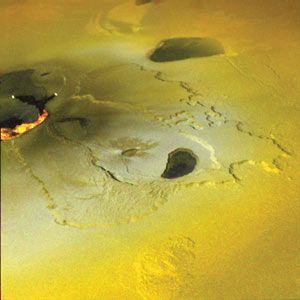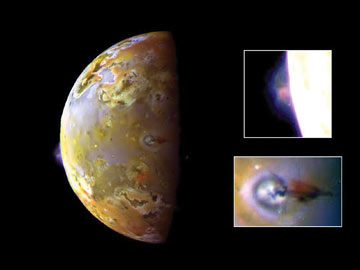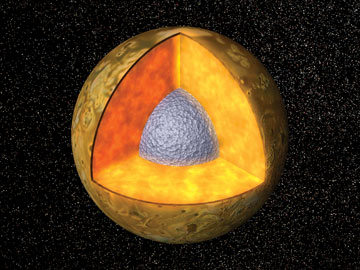|
Travels in Geology May 2008 posted May 14, 2008
Space Travels in Geology: Io: A Different Kind of Hell
Mary Caperton Morton
 NASA/USGS/Tammy Becker and Paul Geissler |
| A mosaic basemap of Io was produced by compositing images from the Voyager 1 and Galileo missions. |
In 1610, using one of the world’s first telescopes, Galileo discovered Jupiter’s moons: Io, Europa, Ganymede and Callisto. For the next several hundred years, astronomers assumed the four moons were similar to our own — icy, cold, pockmarked and geologically dead. But then in 1979, the Voyager probe flew by Io, the closest moon to Jupiter, and returned images of volcanic eruptions hundreds of kilometers high, larger than any ever seen in the solar system. In the 30 years since then, a series of observations has revealed Io to be an inferno more volatile than Dante himself imagined.
Io, a sulfurous rock about the size of Earth’s moon, is bursting with volcanoes. With more than 400 active vents spewing red-hot lava, the moon is by far the most geologically active body in our solar system. Some of Io’s most spectacular eruptions eject plumes of debris nearly 500 kilometers into outer space. Io’s surface churns so vigorously that the landscape is devoid of the impact craters that characterize our moon or planets such as Mars. Instead, Io’s tumultuous surface is covered with vast calderas the size of Texas, huge sulfurous lakes and extensive lava flows.
Io’s volcanism is driven by a different mechanism than Earth’s. While Earth’s internal heat comes from radioactive isotope decay, Io’s main source comes from friction generated by the strong gravitational pull of massive Jupiter and nearby moons Europa and Ganymede. As Io rotates, gravity’s pull creates tidal bulges that are similar to ocean tides, but act instead on waterless Io’s crustal rocks. These bulges can be 100 meters high and they move as the moon spins. Such extreme flexing of the crust creates enormous friction and heat, which has melted most of Io’s interior mantle and iron sulfide core. Known as tidal heating, scientists estimate that this friction generates heat 10 times greater than is found in Earth’s core.
 University of Arizona |
| NASA's Galileo spacecraft captured this image of a volcanic eruption on Io in 2000. The dark areas are lava flows. |
Tidal heating on Io produces the hottest lava found anywhere in the solar system. Infrared measurements have shown vent temperatures in excess of 1,725 degrees Celsius. That’s nearly the hottest temperature in our solar system, second only to the surface of the sun. These blistering vents are probably basaltic, while temperatures at some of Io’s cooler volcanoes are likely to extrude molten sulfur as well, according to Alfred McEwan of the University of Arizona in Tucson and colleagues who reported on the moon’s makeup in Science in 1998.
When the Galileo space probe visited Io in 1995, it accidentally flew through one of the moon’s massive eruption plumes. The probe survived because the plume turned out to be composed of frozen sulfur dioxide snowflakes. Although Io’s volcanoes are scorching hot, because of its distance from the sun and a lack of atmosphere, Io’s surface is actually frigid. The plumes form when underground pools of liquid sulfur dioxide come into contact with hot zones and the sulfur explodes to the surface as a column of superheated gas, similar to Earth’s geysers. But upon contact with surface temperatures as low as minus 150 degrees Celsius, the gas condenses into sulfur snowflakes, which shoot, unimpeded by gravity or atmosphere, hundreds of kilometers above Io’s surface. The Galileo probe flew by Io 10 times during its seven-year visit with Jupiter and observed these sulfurous geysers erupting from as many as 80 vents, some for months at a time.
 NASA/JPL |
| Two sulfurous eruptions are visible on Io in this composite image from Galileo. On the horizon, a bluish plume rises about 140 kilometers above the surface of a volcanic caldera. Near the night/day shadow line, the ring-shaped Prometheus plume rises about 75 kilometers. The Prometheus plume is visible in every image ever taken of the region dating back to the Voyager flybys in 1979. |
Flying through the plume was the least of Galileo’s problems. The space probe’s mission was also fraught with technical problems that made it difficult to gather much information. Io orbits closer to Jupiter than our moon does to Earth, placing it within one of Jupiter’s most intense radiation belts. Debris from Io’s plumes and volcanoes is constantly stripped away by Jupiter, creating a cloud of ions around Jupiter that further inflate the colossal planet’s unusually large magnetic field. This interaction between Io and Jupiter generates an electric current of more than 1 trillion watts — high enough to severely limit the amount of time the Galileo probe could spend gathering information near the moon. After the difficulties of the last Galileo mission, NASA has no further plans to send another probe to explore Jupiter’s moons, so Io is now observed from Earth-based telescopes and by the Hubble Space Telescope.
In 2001, the Keck II telescope on the big island of Hawaii observed the largest recorded volcanic eruption anywhere in the solar system on Io. In an article published in Icarus, researcher Franck Marchis of the University of California at Berkeley called the eruption “the most energetic ever seen.” Fountains of fiery molten lava several kilometers high were observed and extensive surface flows dwarfed eruptions from Earth’s largest volcano, Mount Etna. The eruption changed the landscape of Io dramatically in a matter of days, creating new features that were appropriately named for places in Dante’s Inferno.
 JPL |
| Though unknown, researchers have inferred Io's interior characteristics from gravity fields and magnetic measurements. Io's radius is 1,821 kilometers, similar to our moon, and it has a metallic (mostly iron and nickel) core. The core is surrounded by a rock shell (shown in brown) that is thought to extend to the surface. |
The Hubble Space Telescope has also photographed Io, producing detailed images of the moon’s unique landscape. In addition to volcanoes, Io’s surface is also dotted with massive non-volcanic mountains. Unlike on Earth, Io’s mountains are not the result of tectonic activity. Instead, as the layers of new volcanic material extrude onto the moon’s surface, older deposits of lava are buried and as they sink are compressed. The compressive forces build up until the pressure is relieved through thrust faulting and uplift of large blocks of crustal rock, as reported in 1998 in Science by Paul Schenk of the Lunar and Planetary Institute in Houston, Texas, and Mark Bulmer of the Smithsonian National Air and Space Museum in Washington, D.C. Io’s tallest mountain, Euboea Montes, was created through such a process and, at 15.9 kilometers, it would tower over Earth’s tallest mountains. One Hubble image of Euboea Montes showed a massive landslide on the mountain’s northern flank that produced a Pennsylvania-sized debris apron, by far the largest recorded slide in the solar system.
For such a tiny place, Io holds a lot of solar system records: most volcanoes, hottest temperatures and biggest landslide. Exploration of Io over the past few decades has revealed an extreme, geologically unique world far different from Earth or anywhere else in the solar system. Given its volatility and extreme temperatures, maybe traveling there is best left to the imagination.
Travels in Geology is Geotimes’ monthly online travel exclusive. Although most sites are Earth-based locations anyone can visit, occasionally we like to step outside the bounds and tell you about other cool sites in our galaxy. Visit www.geotimes.org/Travels.html to read more of our Travels features.

 Subscribe
Subscribe


